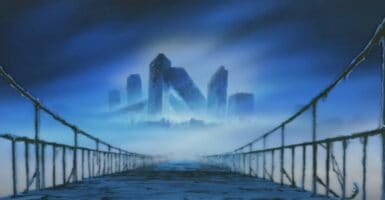Will 3D Printing Be The Future Of Hollywood Special Effects?
This article is more than 2 years old
 While all film genres have, by and large, adapted to the CGI revolution, you’ll always find that horror films, and by extension some science fiction flicks, have steadfastly remained connected to the practical effects that the industry was built upon. Just like CGI has gone from impressive to mind-blowing in the last 20 years, make-up and props have never been better. One need only watch an episode of Syfy‘s Face-Off to see the craft at its best. And it’s possible the future of hands-on film and TV effects is already here, just waiting to be utilized: 3D printing. It seems like the most obvious thing in the world when you think about it.
While all film genres have, by and large, adapted to the CGI revolution, you’ll always find that horror films, and by extension some science fiction flicks, have steadfastly remained connected to the practical effects that the industry was built upon. Just like CGI has gone from impressive to mind-blowing in the last 20 years, make-up and props have never been better. One need only watch an episode of Syfy‘s Face-Off to see the craft at its best. And it’s possible the future of hands-on film and TV effects is already here, just waiting to be utilized: 3D printing. It seems like the most obvious thing in the world when you think about it.
Live Science recently spoke of the various methods of achieving movie magic with Andrew Clement, the owner of Creative Character Engineering in Van Nuys, California, and Mark Coulier, the Academy Award-winning director of the U.K. company Coulier Creatures. The former is responsible for effects on films such as Nightmare on Elm Street and Let Me In, while the latter worked on the Harry Potter franchise and The Iron Lady. Both are openly embracing 3D-printing technology, having already used it in several films.
“It’s an extremely fast way of sculpting and doing concepts,” said Clement. Instead of going into a mask sculpt blind, the effects team can print out an exact version of the look they’re going for, tweaking a digital representation until every aspect is perfect. Then it can be printed over and over again, and any errors wouldn’t take nearly as long to fix as they would if they were working with computer graphics or a one-of-a-kind mold.
“On Harry Potter<,” Coulier said, “we had a big old giant spider we did for the last film and we had to build a smaller version of the same thing, so we had it scanned and 3D printed.”
Many films still use miniatures for large-scale effects scenes, and virtually anything imaginable can be 3D printed on the small side. I have a feeling as soon as the plasticine stop-motion animators get on board with this, all kinds of tiny plastic doors will open up.
That said, Coulier will probably never turn his back on sculpting with his hands. “You get what I call happy accidents when you sculpt things physically with a clay material that just don’t happen when you sculpt on the computer,” he said.
Parts of Iron Man’s costume used in the sequels were created by 3D printers, to make it more lightweight and comfortable for star Robert Downey Jr. I’d assume this is where the tech would really catch on. Faces and more detailed effects should get hands-on treatment, while standard props, costumes, and robot characters should be printed. Somebody make that a rule and put me down as the guy who said it first.
Incidentally, if you’d like to get a good idea of how prevalent practical effects still are, Coulier’s company worked on close to 5,000 make-ups on Marc Forster’s zombie epic World War Z, a film that featured an entire world’s worth of computer-generated landscapes and zombie hordes. There’s no way you can 3D print that.











